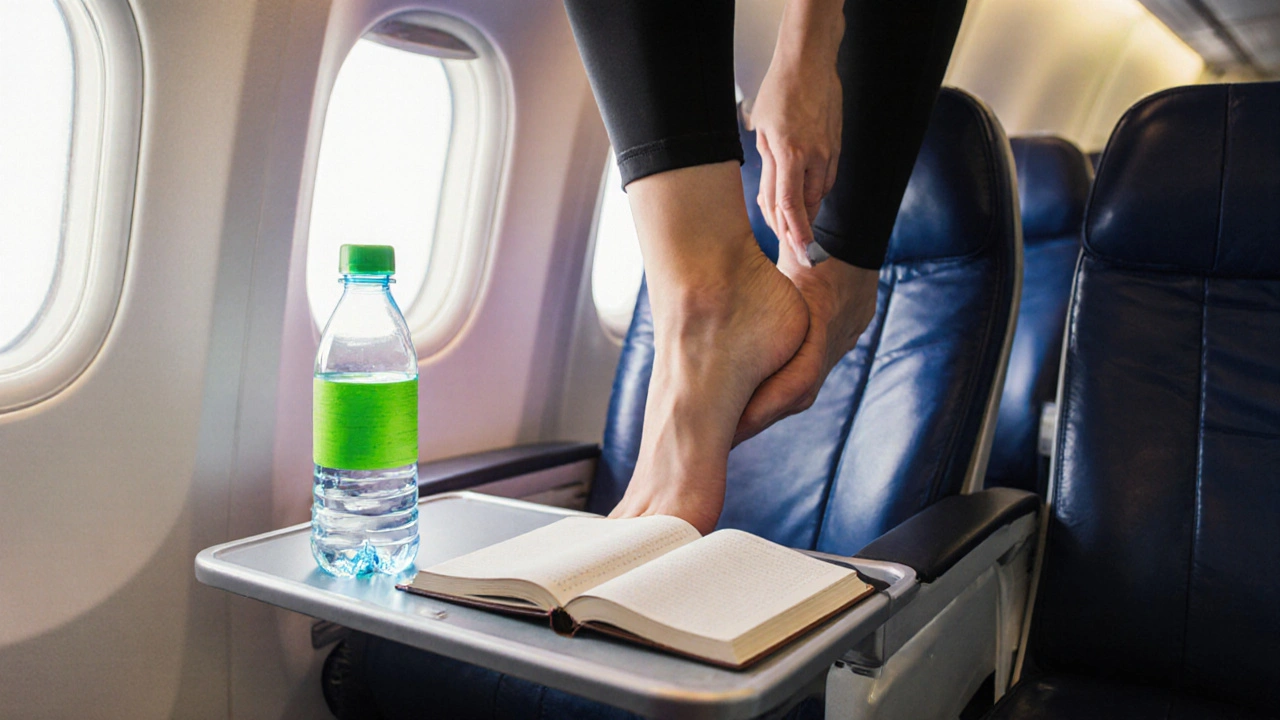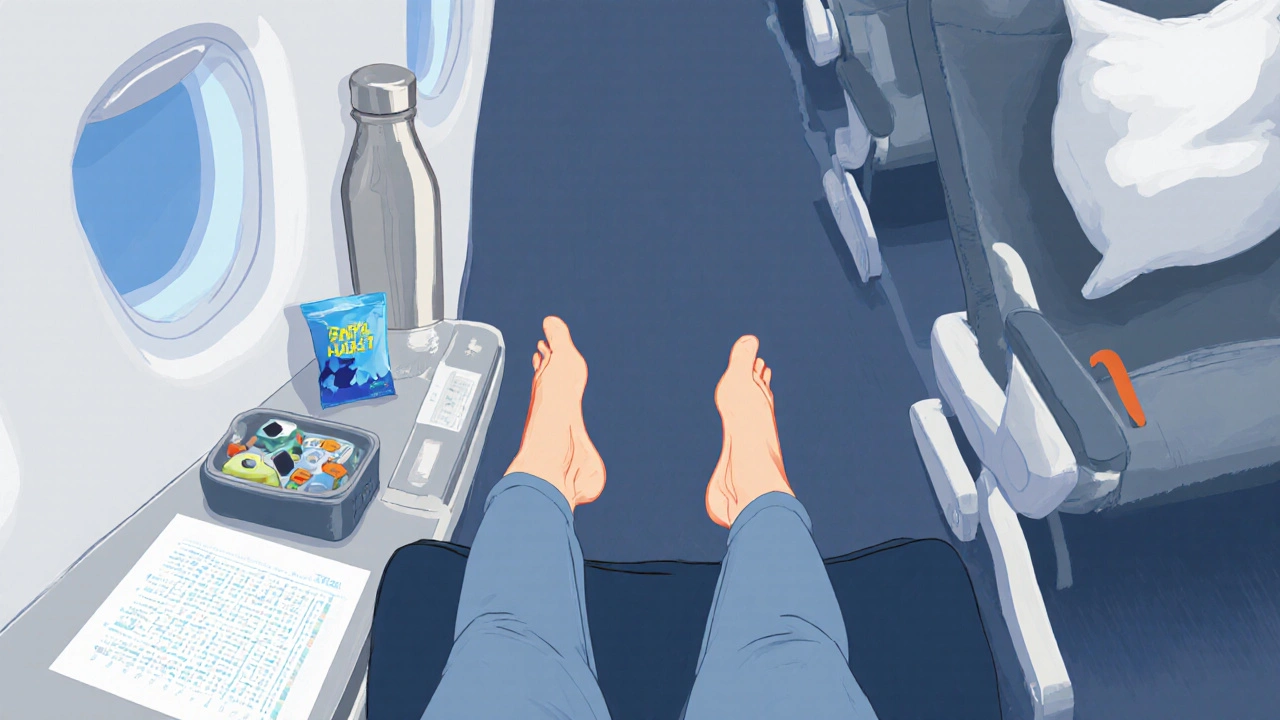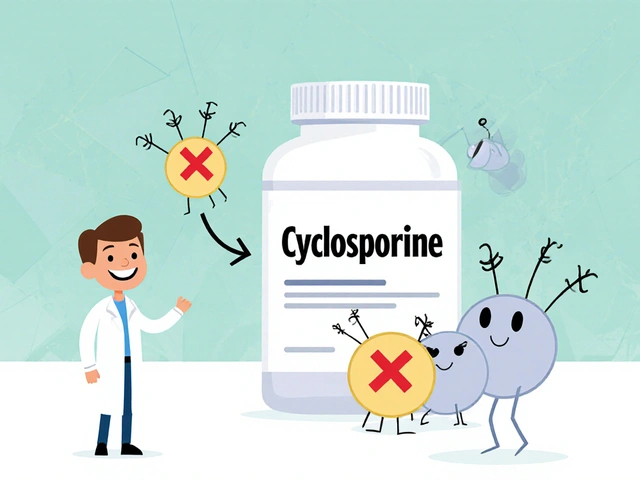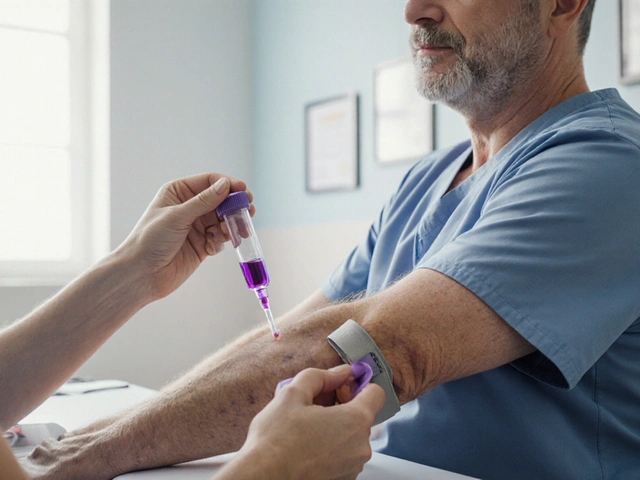
Deep Vein Thrombosis (DVT) is a blood clot that forms in deep veins, most commonly in the legs. The clot can block blood flow, cause swelling, pain, and in severe cases travel to the lungs as a pulmonary embolism. Long‑haul travel is a recognized trigger because sitting for hours encourages venous stasis, dehydration, and reduced calf‑muscle activity.
Why a 12‑hour Flight Can Turn Your Legs Into a Risk Zone
When you stay seated, the venous pump in your calf muscles slows down. Blood pools in the deep veins, raising pressure and making clot formation easier. Cabin air is dry, so you lose fluids faster, thickening the blood. Tight seat belts and cramped seats further compress the vessels. Combined, these factors create a perfect storm for a clot.
Key Risk Factors to Watch Out For
Not everyone faces the same level of danger. Certain characteristics amplify the odds of a clot forming during travel:
- Age over 60 - veins become less elastic.
- Recent surgery or injury - tissue trauma releases clotting factors.
- Obesity - extra weight adds pressure to leg veins.
- Pregnancy or hormone therapy - hormones increase clotting tendency.
- History of DVT or a known clotting disorder.
Identifying these risk factors helps you decide which preventive steps need extra attention.
Core Preventive Strategies
Experts agree that a combination of movement, compression, and proper fluid intake cuts clot risk dramatically. Below are the most evidence‑backed tactics.
Compression Stockings
Compression stockings are specially designed hosiery that apply graduated pressure-strongest at the ankle, easing toward the thigh. The pressure squeezes veins, forcing blood upward and reducing venous stasis. Studies show a 50‑70% drop in DVT incidence for travellers who wear class‑2 (15‑21mmHg) stockings on flights longer than 4hours.
Stay Hydrated
Drinking water not only keeps you comfortable; it thins the blood. Aim for at least 2liters of fluid before boarding and sip regularly during the flight. Avoid alcohol and caffeine, which increase urine output and can lead to dehydration.
Leg Exercises and Frequent Walking
Every 30‑60minutes, stand up (if safe) and walk down the aisle for a minute. While seated, perform simple ankle pumps: flex your foot upward, then point it down, repeating 10‑15 times. These moves activate the calf‑muscle pump, propelling venous blood back to the heart.
Anticoagulant Medication (When Needed)
If you belong to a high‑risk group-recent major surgery, known clotting disorder, or a previous DVT-your doctor may prescribe a low‑dose anticoagulant such as rivaroxaban or low‑molecular‑weight heparin before a long trip. The medication reduces clot‑forming proteins in the blood, offering an extra safety net. Always discuss dosage and timing with a healthcare professional.
Additional Tips That Complement the Core Measures
- Select an aisle seat when possible, making stand‑up breaks easier.
- Keep your knees slightly apart to avoid compressing veins.
- Wear loose‑fitting clothing that doesn’t restrict leg circulation.
- Consider a brief medical check‑up before a prolonged journey, especially if you have known risk factors.
- Travel insurance that covers medical emergencies related to clotting can be a peace‑of‑mind addition.

How the Main Preventive Measures Stack Up
| Measure | Recommended Use | Effectiveness (% reduction in DVT risk) | Typical Cost (UK) |
|---|---|---|---|
| Compression stockings | Wear on flights >4h, class2 or 3 | 55‑70 | £20‑£45 |
| Leg exercises | Every 30‑60min; ankle pumps, calf raises | 30‑45 | Free |
| Hydration | 2L before, sip regularly during | 25‑35 | £5‑£10 (bottled water) |
| Anticoagulant meds | Prescribed for high‑risk travellers | 80‑90 | £15‑£30 per dose |
Related Concepts You Might Explore Next
Understanding DVT ties into several broader health topics. For a deeper dive, you could look at pulmonary embolism, the dangerous sequel when a clot travels to the lungs. Another angle is vascular ultrasound, the non‑invasive test doctors use to confirm a clot. Finally, learning about travel medical insurance helps you plan for unexpected health events abroad.
Quick “Travel‑Ready” Checklist
- Schedule a brief health review 1‑2weeks before the flight.
- Buy class‑2 compression stockings in the correct size.
- Pack a reusable water bottle and set reminders to drink.
- Print a list of simple leg‑exercise moves and keep it handy.
- If prescribed, arrange for anticoagulant medication and understand timing.
- Choose an aisle seat and wear loose clothing.
By following these steps, you dramatically lower the chance that a long journey turns into a medical emergency. The most effective approach is a blend: DVT prevention works best when compression, movement, and hydration all play a part.

Frequently Asked Questions
Can I wear regular socks instead of compression stockings?
Regular socks don’t provide the graduated pressure needed to assist the venous pump. Compression stockings are engineered to exert 15‑21mmHg at the ankle, easing to 8‑12mmHg near the thigh. This gradient is what actually pushes blood upward. Using ordinary socks offers no measurable protection against clot formation on a long flight.
How much water should I drink during a 10‑hour flight?
Aim for about 500ml (≈2 cups) in the first hour after boarding, then a small glass every 30‑45minutes. Total intake of roughly 2liters over the whole journey keeps blood viscosity low without causing trips to the lavatory every few minutes.
Is it safe to take aspirin as a preventive measure?
Aspirin has mild antiplatelet effects, but it isn’t strong enough for high‑risk travellers. Doctors typically prescribe a direct‑acting anticoagulant (e.g., rivaroxaban) rather than aspirin for travel‑related DVT prevention. Always get a prescription before using any medication for clot prevention.
What if I can’t stand up because the flight is full?
Even seated ankle pumps help. Flex your feet upward, then point them down, repeating 10‑15 times. You can also do a seated “figure‑four” stretch: lift one ankle onto the opposite knee and gently press down on the raised knee. These motions keep the calf‑muscle pump active without leaving your seat.
Should I get a duplex ultrasound after a long flight?
Routine screening isn’t recommended for low‑risk passengers. However, if you notice swelling, pain, or discoloration in a leg within 48hours after travel, seek medical attention. A duplex ultrasound is the gold‑standard test to confirm or rule out a clot.




Burl Henderson
September 26, 2025 AT 14:00Leveraging the concept of venous shear stress, the article nails the synergy between graduated compression and calf‑pump activation; those two mechanisms together create a hemodynamic environment that markedly lowers stasis. I’d add that selecting stockings with a proper gradient-15‑21 mmHg at the ankle tapering to 8‑10 mmHg proximally-optimizes the transmural pressure differential. Also, integrating intermittent pneumatic compression (IPC) for patients with known thrombophilia can further amplify flow velocity. Hydration isn’t just about volume; electrolyte balance sustains plasma osmolarity, which subtly influences clotting factor kinetics. Finally, timing anticoagulant dosing within the pre‑flight window (usually 2‑4 hours before boarding) aligns peak plasma concentration with the period of maximal immobilization.
Leigh Ann Jones
October 5, 2025 AT 20:13The piece does a decent job of laying out the basics, but let me expand on why each recommendation matters in the broader context of vascular physiology and travel logistics. First, compression stockings are not a fashion statement; their graduated pressure profile mimics the natural muscle pump, channeling blood toward the heart and preventing retrograde flow. Second, staying hydrated does more than thin the blood-it maintains endothelial function and reduces viscosity, which together lower the risk of platelet aggregation. Third, regular ambulation every half hour should be considered a non‑negotiable protocol; even a brief aisle walk can double venous return compared to seated calf pumps alone. Fourth, the ankle pump exercise, while simple, activates the deep calf muscles, which constitute the primary driver of the venous reservoir; performing 10‑15 repetitions each interval can offset the stasis that accumulates during prolonged seating. Fifth, for high‑risk individuals, pre‑flight anticoagulation isn’t a luxury but a prophylactic necessity, with direct oral anticoagulants offering predictable pharmacokinetics compared to low‑molecular‑weight heparin. Sixth, the selection of an aisle seat, though trivial sounding, reduces the friction of standing up, encouraging more frequent movement. Seventh, loose clothing eliminates extrinsic compression that could otherwise exacerbate venous pressure. Eighth, a brief pre‑travel medical review can catch asymptomatic hypercoagulable states that might otherwise go unnoticed. Ninth, travel insurance that explicitly covers clot‑related events can spare you from costly emergency care abroad. Tenth, the post‑flight self‑assessment checklist-monitoring for unilateral swelling, warmth, or discoloration-should be adhered to for at least 48 hours, as delayed presentations are not uncommon. Eleventh, the use of a personal water bottle with time‑marked reminders can help you stay on schedule with fluid intake. Twelfth, avoiding alcohol and excess caffeine eliminates diuretic‑induced dehydration, which would counteract your hydration efforts. Thirteenth, for those who cannot stand due to full flights, seated figure‑four stretches provide a modest mechanical advantage to the deep veins without leaving the seat. Fourteenth, in the rare event of a suspected DVT, a duplex ultrasound remains the gold‑standard diagnostic tool. Fifteenth, remember that the combination of compression, movement, and hydration is synergistic; omitting any one component significantly reduces overall protective efficacy.
Sarah Hoppes
October 15, 2025 AT 02:26They left out that the airline industry is secretly testing blood‑thinners in the cabin air and that the “hydration tips” are a cover‑up for the real agenda
Robert Brown
October 24, 2025 AT 08:40Nice fluff, but the science is overhyped.
Erin Smith
November 2, 2025 AT 13:53Keep it simple stay hydrated and move a bit you’ll be fine
George Kent
November 11, 2025 AT 20:06Well, frankly this article could use a proper comma after "compression," and a semicolon before "Hydration" – proper punctuation matters! 😊 Also, it’s absurd to ignore the fact that British travellers have been using compression stockings for decades-our NHS guidelines are crystal clear on this. 🇬🇧
Jonathan Martens
November 21, 2025 AT 02:20Ah, the classic “just wear stockings” advice-so original, yet undeniably effective when you consider the shear‑rate modulation it induces in the venous endothelium. Of course, the real magic is in coupling that with micro‑vascular recruitment during intermittent ambulation, a nuance many overlook.
Jessica Davies
November 30, 2025 AT 08:33While the article touts “practical tips,” it barely scratches the surface of the existential peril that a clot represents to the human condition. One must contemplate the metaphysical implications of stagnation, both physiological and societal, before embarking on any transatlantic odyssey.
Kyle Rhines
December 9, 2025 AT 14:46The grammar in the original piece is riddled with inconsistencies; for instance, "travellers" should be "travelers" in American English. Also, the claim about “50‑70% drop” lacks citation-another classic data‑absence tactic.
Lin Zhao
December 18, 2025 AT 21:00Great rundown! 👍 It’s reassuring to see a balanced approach that mixes both medical guidance and practical travel hacks. Keep the positivity coming!
Laneeka Mcrae
December 28, 2025 AT 03:13Actually, the most effective preventive measure is the early use of low‑dose rivaroxaban for anyone over 50 on a flight longer than six hours, regardless of other risk factors. The data is clear, and the guidelines are moving in that direction.
Kendra Barnett
January 6, 2026 AT 09:26Remember, consistency is key-make a habit of packing your compression socks and a water bottle in your carry‑on. You’ve got this!